Shrubs are the dependable workhorses of the landscape. They anchor our foundation plantings, line up obediently in rows for hedges and provide a great background for the divas of the garden — showy annuals and perennials.
But some flowering shrubs get downright huffy if you call them “dependable” and “workhorses.”
They have spectacular blooms that stop you in your garden path tracks. Or they offer up such intoxicating fragrance, you make excuses to go outside, just to inhale, and swoon.
Colorful, fragrant shrubs, we salute you. Here are nine of the best shrubs for the northeast.
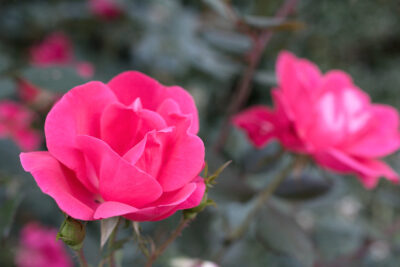 Knock Out Roses
Knock Out Roses
They’re called “knock out” for a reason. Knock Out roses are landscape stunners, offering compact pink and red roses that flower all summer and resist pests and diseases. They can be maintained as nicely shaped shrubs 3 to 4 feet tall. Plant them in large groups to create a colorful hedge or along a foundation for a show-stopping border.
They prefer sun but do well in partial shade. Knockouts are known as “self-cleaning” roses, so you don’t need to deadhead them — aka removing the flowers after they fade. But for the best blooms, cut them back every year in early spring after the last threat of frost.
Pro tip: While you’re at it, feed them a good organic or chemical granular rose food for their first spring feeding to get these beauties off to a good start.
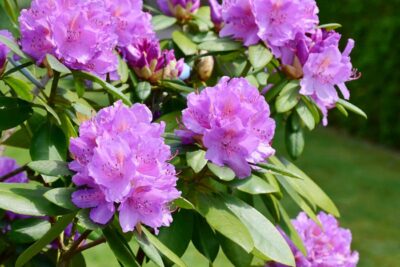 Rhododendron
Rhododendron
Rhododendron has been a favorite of gardeners for generations, in large part for its spectacular spring flowers that bloom in large, showy clusters in vivid pinks, purples, yellows, and reds.
The challenge: how to choose. They grow in all sizes and shapes, from low-growing ground covers to medium-sized shrubs to tree-size plants. Slow-growing dwarf or compact varieties are a smart choice for under windows.
You can find a rhododendron to fit any spot in your landscape.
The American Rhododendron Society website has information about more than 2,000 different rhododendrons and azaleas in searchable lists. Search by flower color, height at 10 years, bloom time, fragrance and more to find just the right variety.
Pro tip: They like a layer of compost each spring, spread out to the outermost branches. Add a 2-inch layer of mulch to retain moisture and control weeds, keeping mulch a few inches away from the trunk.
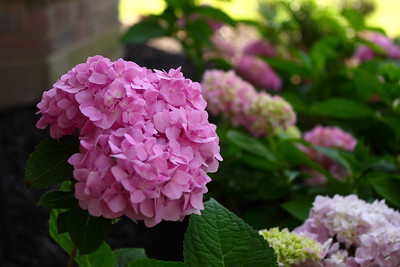 ‘Endless Summer’ Hydrangea
‘Endless Summer’ Hydrangea
Pretty pink, bright lavender, vivid blue — find it all with ‘Endless Summer’ hydrangeas, which offer large floppy, old-fashioned blooms. In neutral soil, expect ball-shaped, pink and lavender blossoms. In slightly acidic soil, they’ll bloom deep blue.
‘Endless Summer’ has the unique ability to re-bloom throughout the spring and summer months, giving more color and visual appeal to your landscape for a longer period of time.
Here in the northeast, plant them in a location that allows for full morning sun with dappled shade in the afternoon.
Pro tip: Their soil preference is loam, so if you have a heavy clay soil, add gypsum to the soil to break up the clay and allow for drainage. In sandy soil, adding peat moss can help absorb moisture. And don’t skimp on the compost — they love it.
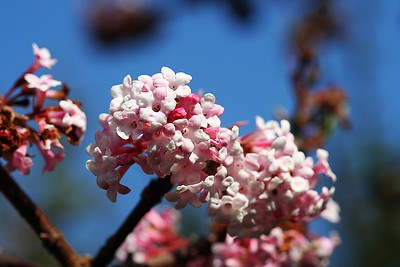 Korean Spice Viburnum
Korean Spice Viburnum
This is a pretty shrub, with white or pink-flushed flowers in domed clusters. But you’ll smell its real appeal as soon as you inhale. Sniff — they smell like spice cake. The plant also has pretty red foliage and berries in the fall. It grows to about 6 feet tall and wide.
Plant this intoxicating shrub where you can really enjoy it — near the patio where you savor your morning coffee, along with the path to your door, or near a window you like to open for balmy breezes.
Korean spice viburnum prefers full sun to partial shade. These bushes grow best in a moist but well-drained ground that has a soil pH on the acidic side.
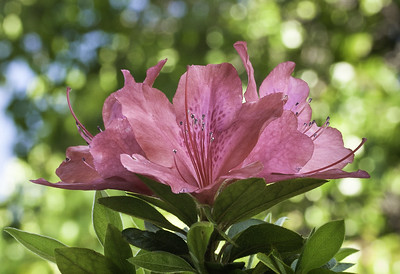 Encore Azalea
Encore Azalea
Encore is a group of azalea hybrids that bloom in spring, then again in late summer, early fall. Their multi-season flower display makes them one of the most popular landscape shrubs out there.
Plants bloom either white, pink, red, or purple and grow to a height and spread of 3 to 5 feet.
Plant them in full sun or high filtered shade. They’re great for sunny spots that would wilt traditional azaleas.
Pro tip: They’re happiest in acidic soil that’s been prepped with plenty of compost, with pH between 5.0 and 5.5 Plant them in raised beds or flower beds offering good drainage.
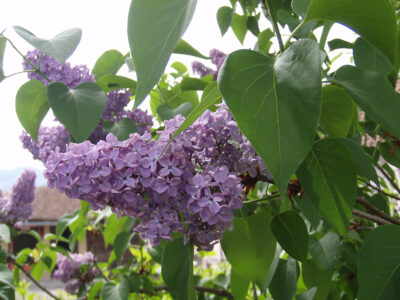
Bloomerang Lilac
If you love the heavenly scent of lilacs, but their skimpy two-week bloom time makes you grouchy, check out the Bloomerang variety.
Bloomerang makes its first heavy bloom in mid-May. In June, this dwarf flowering shrub rests, then begins reblooming in July, continuing until frost.
Unlike many lilacs, Bloomerang hasn’t shown much susceptibility to common diseases like powdery mildew.
Bloomerang lilac reblooms on new growth, so light pruning and fertilizing encourages that.
It does best in fertile, well-drained soil.
Bonus: Expect hummingbirds.
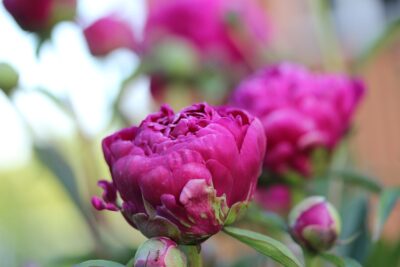 Peonies
Peonies
It’s hard to resist the old-fashioned beauty and charm of peonies, which offer up about the prettiest pink blossoms you’ll ever see, with little muss or fuss.
And they smell lovely.
They’re disease-resistant, so they don’t need pesticides, and once established, they don’t need a lot of water.
You do need to be patient. Peonies can take a few years to settle in once they’re planted, but they’ll live for hundreds of years. They’ll be your pretty pink legacy.
It’s best to plant these from bare roots. Be sure the roots are fleshy and firm.
Bonus: Peonies make great cut flowers, so you can enjoy bountiful, fragrant bouquets inside.
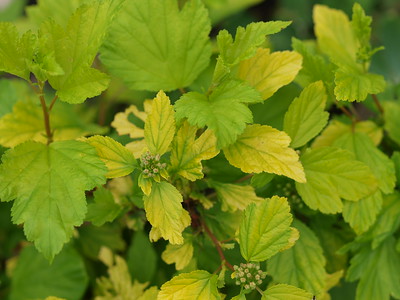 Dart’s Gold Ninebark
Dart’s Gold Ninebark
We’re veering from beautiful blooms for a minute to focus on a shrub known for its vibrant color — in its leaves.
Dart’s Gold Ninebark boasts striking foliage on a compact, mounded shrub. Large maple-like leaves emerge such a bright golden yellow in spring that people often mistake it for forsythia.
The leaves change to a zippy lime green in summer, then take on a golden hue with a bronze tint in fall. Small white flowers bloom in dense clusters, followed by small red fruit.
It grows to about 6 feet tall and 8 feet wide and likes full sun to part shade. It’s a sturdy shrub, tolerating drought, erosion, clay soil and dry soil.
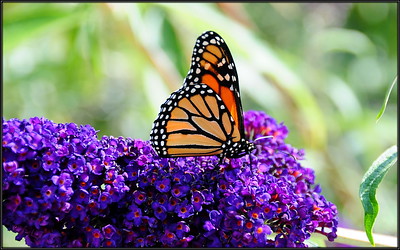 Butterfly Bush
Butterfly Bush
Butterfly bush is a beautiful bloomer, exploding in hues of purple, lavender, blue, pink, and white. And it’s deliciously fragrant, with a fruity scent that attracts butterflies and hummingbirds like crazy.
To nurture a butterfly bush through cold northern winters, spread mulch up to 6 inches deep around the trunk. Plants will die down but resprout in late spring. Prune to the ground to encourage new growth and a more fountain-like shape.
It prefers full sun and well-drained soil and will grow to 10 feet tall.
Pro tip: Resist the urge to fertilize — extra-fertile soil fosters leafy growth rather than flower spikes. Remove spent flower spikes to encourage new shoots and flower buds.
Neave Knows The Best Shrubs For The Northeast, Hudson Valley, And Your Business
Neave Landscape Management has been creating beautiful landscapes for more than 50 years. Our experts have a great handle on all kinds of growing things, including the best choices for fast-growing, colorful, fragrant shrubs.
The professionals at Neave will visit your property and discuss the options that will work best in your landscape.
At Neave Group, we’re all about creating a better way of life. Leave the planting to us. Then, enjoy your new additions. Don’t forget to sniff.
If you’re in the Hudson Valley, call us at (845) 463-0592. If you’re in Westchester County, call (914) 271-7996; from New Jersey, dial (201) 591-4570; from Connecticut, dial (203) 212-4800. Or, fill out our simple web form, and we’ll contact you about setting up your free consultation.
Images: Knock Out roses, Rhododendron, Hydrangea, Viburnum, Azalea, Lilac, Peonies, Ninebark, Buddleia